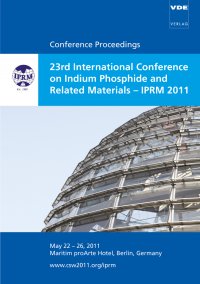In situ characterization of III-V/Si(100) anti-phase disorder
Konferenz: IPRM 2011 - 23th International Conference on Indium Phosphide and Related Materials
22.05.2011 - 26.05.2011 in Berlin, Germany
Tagungsband: IPRM 2011
Seiten: 4Sprache: EnglischTyp: PDF
Persönliche VDE-Mitglieder erhalten auf diesen Artikel 10% Rabatt
Autoren:
Doscher, Henning; Supplie, Oliver; Bruckner, Sebastian; Hannappel, Thomas (Helmholtz Zentrum Berlin, Hahn-Meitner-Platz 1,14109 Berlin, Germany)
Inhalt:
In situ reflectance anisotropy spectroscopy (RAS) was applied as a quantitative probe of anti-phase domains (APDs) in heteroepitaxial films deposited on Si(100). Based on control of signal changes due to temperature, surface reconstruction, atomic order, and excess phosphorus, the characteristic in situ RAS signature of the P-rich surface enables comparative investigation of heteroepitaxial versus homoepitaxial GaP films. We observed a linear reduction of the RAS signal according to the presence of anti-phase disorder, which was utilized for quantifying APDs. However, RA spectra of heteroepitaxial GaP/Si(100) films contained further deviations from the reference signal of homoepitaxial GaP(100), which originate from reflections at the additional GaP/Si(100) heterointerface. Since the major source of deviations is interference affecting the normalization of the RAS signal, empirical corrections improve the quantification results in general. However, at photon energies around 3.2 eV, the correction even amplified the difference between the spectra of GaP/Si(100) and GaP(100) samples. Eventually, model calculation of the surface and interface dielectric anisotropies indicate the presence of additional optical anisotropy induced by the GaP/Si(100) interface reflection.


